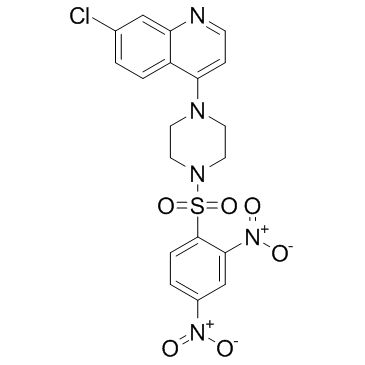VR23
Modify Date: 2025-08-25 20:15:48

VR23 structure
|
Common Name | VR23 | ||
|---|---|---|---|---|
| CAS Number | 1624602-30-7 | Molecular Weight | 477.878 | |
| Density | 1.6±0.1 g/cm3 | Boiling Point | 699.3±65.0 °C at 760 mmHg | |
| Molecular Formula | C19H16ClN5O6S | Melting Point | N/A | |
| MSDS | N/A | Flash Point | 376.7±34.3 °C | |
Use of VR23VR23 is a small molecule that potently inhibited the activities of trypsin-like proteasomes (IC50 = 1 nM), chymotrypsin-like proteasomes (IC50 = 50-100 nM), and caspase-like proteasomes (IC50 = 3 μM).IC50 value: 1 nM (trypsin-like proteasome), 50-100 nM(chymotrypsin-like proteasome), 3 μM (caspase-like proteasome)Target: proteasomein vitro: VR23 is a novel proteasome inhibitor targeting β2 of the 20S proteasome subunit. VR23 produces a synergistic effect in killing multiple myeloma cells, including those that were resistant to bortezomib. VR23 as a structurally novel proteasome inhibitor with desirable properties as an anticancer agent.in vivo: VR23 shows effective antitumor and antiangiogenic activities in mice. |
| Name | 7-Chloro-4-[4-[(2,4-dinitrophenyl)sulfonyl]-1-piperazinyl]quinoline |
|---|---|
| Synonym | More Synonyms |
| Description | VR23 is a small molecule that potently inhibited the activities of trypsin-like proteasomes (IC50 = 1 nM), chymotrypsin-like proteasomes (IC50 = 50-100 nM), and caspase-like proteasomes (IC50 = 3 μM).IC50 value: 1 nM (trypsin-like proteasome), 50-100 nM(chymotrypsin-like proteasome), 3 μM (caspase-like proteasome)Target: proteasomein vitro: VR23 is a novel proteasome inhibitor targeting β2 of the 20S proteasome subunit. VR23 produces a synergistic effect in killing multiple myeloma cells, including those that were resistant to bortezomib. VR23 as a structurally novel proteasome inhibitor with desirable properties as an anticancer agent.in vivo: VR23 shows effective antitumor and antiangiogenic activities in mice. |
|---|---|
| Related Catalog | |
| References |
| Density | 1.6±0.1 g/cm3 |
|---|---|
| Boiling Point | 699.3±65.0 °C at 760 mmHg |
| Molecular Formula | C19H16ClN5O6S |
| Molecular Weight | 477.878 |
| Flash Point | 376.7±34.3 °C |
| Exact Mass | 477.050995 |
| LogP | 3.49 |
| Vapour Pressure | 0.0±2.2 mmHg at 25°C |
| Index of Refraction | 1.697 |
| InChIKey | PDQVZPPIHADUOO-UHFFFAOYSA-N |
| SMILES | O=[N+]([O-])c1ccc(S(=O)(=O)N2CCN(c3ccnc4cc(Cl)ccc34)CC2)c([N+](=O)[O-])c1 |
| Storage condition | -20℃ |
| 7-Chloro-4-{4-[(2,4-dinitrophenyl)sulfonyl]-1-piperazinyl}quinoline |
| Quinoline, 7-chloro-4-[4-[(2,4-dinitrophenyl)sulfonyl]-1-piperazinyl]- |
| VR23 |

